Bernini Sculptures – Discover the Famous Baroque Sculptor
Gian Lorenzo Bernini (1598 – 1680) was an Italian architect and sculptor, who’s work embodied the style of the Baroque period. Bernini was especially renowned for his sculpture work. His pieces were incredibly detailed, often depicting scenes in the midst of action. His expert carving skills created statues and sculptures that were dynamic, in the midst of movement, and often made use of different viewer angles to tell a complete story.
History of Bernini Art
Around the age of eight, sculptor Bernini was already regarded as a prodigy, under the apprenticeship of his father Pietro Bernini, a capable Florentine sculptor who later settled in Rome, his career took off. With the support of its patrons, the cardinals and popes, his art blossomed and came to dominate the Roman art scene of the period. Italy was in awe when 13-year-old Gian Lorenzo Bernini produced a bust of the surgeon Antonio Coppola. It was one of Bernini’s early psychologically penetrating busts, and according to Bernini, it was not his first piece.
 Portrait of Antonio Coppola (1612) by Gian Lorenzo Bernini; Gian Lorenzo Bernini, CC BY 3.0, via Wikimedia Commons
Portrait of Antonio Coppola (1612) by Gian Lorenzo Bernini; Gian Lorenzo Bernini, CC BY 3.0, via Wikimedia Commons
Bernini would again demonstrate in the years that followed his mastery of sculpture. Bernini demonstrated his skill at bringing life to bronze and marble while working during a period when painting was still thought to be the most significant and recognized creative medium. His talent made him a favorite of the upper-class Romans, and the works he produced for them have stood the test of time and are considered some of the most significant pieces of art on display in the city. One scholar even described Bernini as the first pan-European sculptor with an extraordinary influence and whose name is instantly linked to a particular style and vision, adding; “What Shakespeare is to drama, Bernini may be to sculpture.”
Bernini, like Michelangelo before him, mastered marble while continuing to be as adept in other mediums. His approach and vision were so avant-garde that they helped usher in a new period of European sculpture that continues to have an impact on the genre today. Together with Pietro da Cortona, an architect and painter, and Francesco Borromini, an architect, Bernini was a key player in the development of Roman Baroque architecture.
In an ambitious urban planning project undertaken under his sponsorship by the influential Roman Popes of the period, his designs assisted in restoring Rome to its former architectural splendour.
Bernini was driven by primarily by passion. His dynamic and flamboyant style centered on emotional expressionism, which came as a result of his strong religious beliefs and a lifetime of study of the sculptural form, brilliantly capturing the Baroque era. He outshined other sculptors of his age thanks to his vast versatility in technical skill, limitless compositional creativity, and absolute mastery of marble manipulation. He was also a painter and patron of the theater, writing, directing, and acting in plays (usually satires on the Carnival), for which he created stage props and other theatrical equipment. He also created designs for other pieces of ornamental art, such as tables, mirrors, lamps, and even carriages.
Bernini’s Art
Sculpture played a significant role in the Baroque period, and Bernini is best known for his incredibly designed sculpted pieces. Bernini received his initial training in his father Pietro’s Roman studio, where he helped create sculptures. One of his earliest independent pieces, the classically inspired Bacchanal: A Faun Teased by Children (1616 – 1617), adopts the Mannerist pattern of intertwined figures as its starting point.
Bernini quickly became a well-known sculptor under the patronage of the wealthy, influential and powerful Cardinal Scipione Borghese. One of his earliest creations for the cardinal was The Goat Amalthea with the Infant Jupiter and a Faun (1609 – 1615) a garden ornament for the Villa Borghese. The majority of art historians agree that this marble sculpture is the earliest piece created completely by Bernini himself.
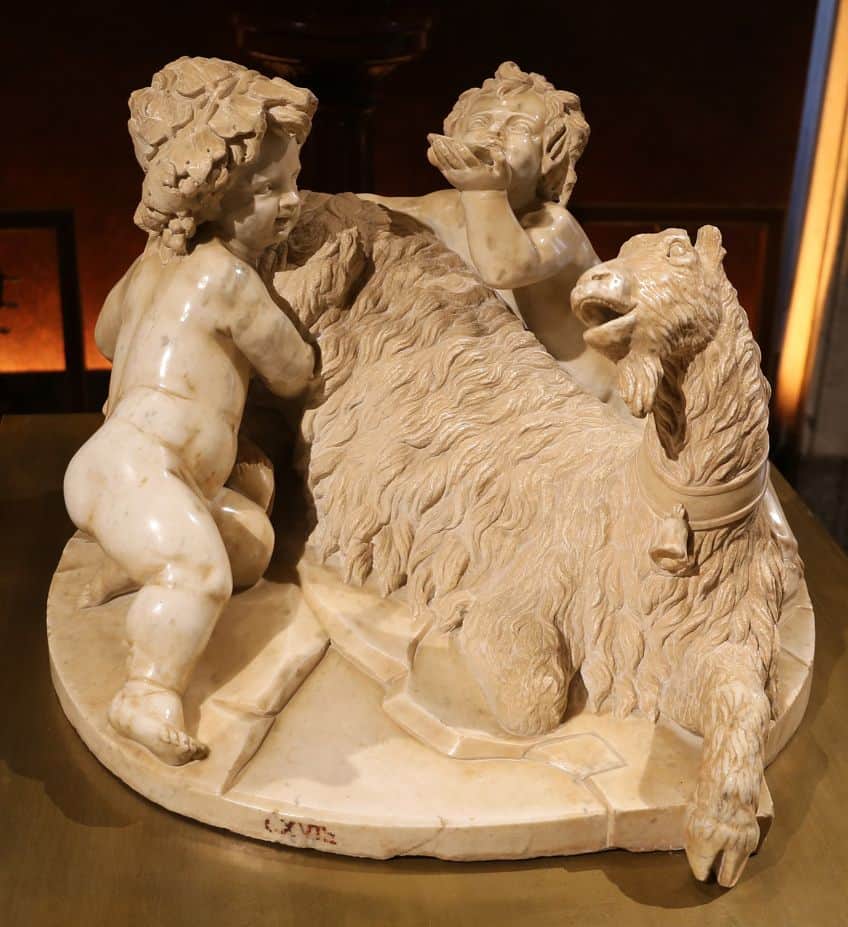
Bernini’s reverence in the art world was evident, with historians finding a letter dated to 1618 written by Maffeo Barberini to his brother, Carlo. The letter stated that Barberini was considering asking the then-young Bernini to finish an incomplete Michelangelo statue, which Barberini was planning on purchasing from Michelangelo’s grandnephew. While this commission never took place, Bernini was commissioned a few years later to repair and finish a sleeping Hermaphrodite (date unknown) statue, by Cardinal Scipione Borghese. Sculptor Bernini’s innovative style and position as the top sculptor in Italy came from his work on a series of over-life-size marble sculptures that Cardinal Borghese ordered for his residence in Rome. One of these sculptures was the Apollo and Daphne (1622- 1624) statue, which perfectly expresses the style and themes of Baroque art.
Like Michelangelo before him, Bernini carved a statue of David. (1623) While Michelangelo’s David (1501 – 1504) was more static in its pose, Bernini’s David statue was dynamic, through the artist’s use of torsion in the figure’s sculpt. Bernini created a new, distinctly Baroque interpretation for religious and historical sculptures, strongly imbued with dramatic realism, emotion, and dynamic, theatrical compositions. He did this by combining and adapting the classical elegance of Renaissance sculpture and the dynamic energy of the Mannerist period.
Early Bernini statues and sculptures show this mastery of the human form in dynamic motion and a technical skill comparable to the greatest sculptors of Classical movement.
Bernini was able to arrange massive sculptures that exuded a magnificent elegance as well as reflect extremely dramatic storylines with individuals displaying profound psychological states. Unlike previous sculptures, Bernini put a great deal of effort to portray dynamic narratives in his statues, such as Aeneas and his family escaping the city of Troy as it goes down in flames; Apollo seeing Daphne transform into a tree; Pluto kidnapping Persephone to take her to the Underworld.
Bernini Sculptures
While Bernini did also dabble in other mediums such as oil paintings, he is primarily revered today for his impressive sculptures. Bernini’s sculptures and architecture display an inventive understanding of themes, application of forms, and a mix of media. He was crucial in creating the dramatic and elegant language of the Baroque style, paving the way for future artists.

Bacchanal: a faun teased by children (1616 – 1617 CE)
| Date | 1616 – 1617 CE |
| Medium | Marble |
| Height (cm) | 132,4 |
| Current Location | Metropolitan Museum of Art, New York City, United States |
Bernini and his father, Pietro, created this marble sculpture, entitled Bacchanal: A Faun Teased by Children. It was carried out between 1616 and 1617, while Bernini was under the age of twenty. The sculpture depicts a drunk faun, also known as a satyr, being playfully shoved by unclothed sprites, known as putti, as he pushes forward to harvest grapes. The faun, in Roman mythology, is known as the followers of the wine god, Bacchus, and are often depicted in art in various forms of intoxication. Initially, this sculpture was not recognized as a Bernini creation. The sculpture was kept in storage rather than on display, due to one of the putti figure’s having an incomplete elbow on its left arm. The thin bit of marble that was left after construction wasn’t sufficient enough to complete the carving of the flawed arm, so the piece remained incomplete.
This error scared off potential patrons, leaving the artwork in storage in Bernini’s home.
A few centuries later, the artwork made its way to a French gallery collection, making its way to a Parisian auction house in 1972. Today, the piece can be found in the Metropolitan Museum in New York. This bacchic scene, which was inspired by ancient sarcophagi, demonstrates Bernini’s boldness in defying antiquity. With the piece’s complicated composition of intertwined figures that was skilfully sculpted from a small block, Bernini pushed the boundaries of sculpture. He depicts a variety of motifs in the various marble textures, including the flexible child-like forms of the sprites, one of whom has his tongue out, as well as the smooth, tense muscles of the toothless faun, the tree’s bark and the luscious fruits. Like many of Bernini’s statues, the drama of the piece becomes more evident as the viewer circles it. The figures’ appropriate appearance of precarious, drunken balance is achieved through ingenious engineering, which still allows the sculpture to maintain its own weight.
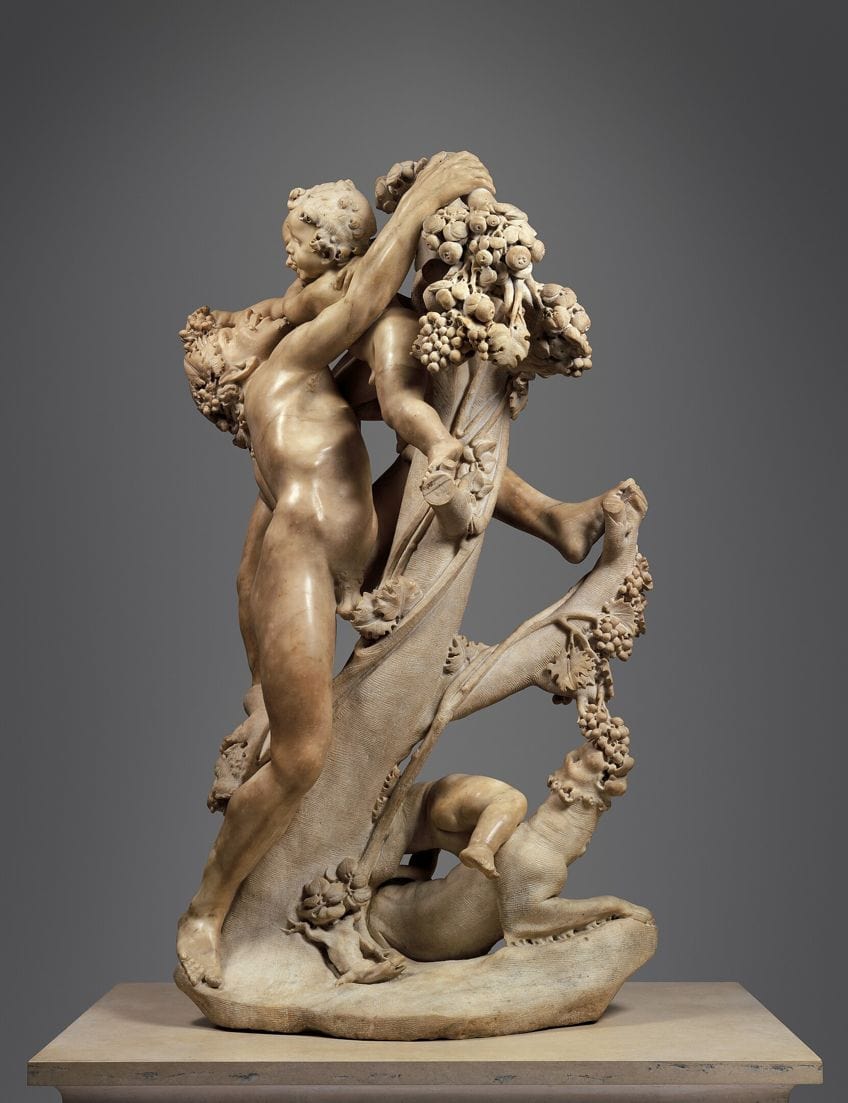
Aeneas, Anchises and Ascanius (1618 – 1619 CE)
| Date | 1618 – 1619 CE |
| Medium | Marble |
| Height (cm) | 220 |
| Current Location | Borghese Gallery and Museum, Rome, Italy |
This Bernini sculpture portrays a scene from Virgil’s Aeneid (1681), in which the hero Aeneas leads his family out of the burning city of Troy. This mythical story is especially significant as Aeneas, a Trojan who fled his home city and eventually settled in Italy, became the fabled forefather of the Romans. The precise situation shown in this sculpture is when Aeneas departs from Troy with his father, Anchises and his young son, Ascancius (his son), after the Greek army had ravaged the city.
The Aeneas figure looks sideways with a determined purpose. The figure also has a lion skin wrapped around his body, a common indicator of demi-god status, as Aeneas was the mythical son of the Goddess Aphrodite. Anchises is holding a vase containing his ancestor’s ashes in it, and on the top are two little sculptures of Di Penates, Roman household gods.
Created while Bernini was 20 years old, it is said that his father Pietro, who was well known for his Mannerist sculptures and papal commissions, assisted him.
Cardinal Scipione Borghese was drawn to the sculpture and would subsequently request other works from him. Bernini was influenced by earlier sculptures by well-known artists, including St. John the Baptist (1612 – 1615) by his father, Fire at the Borgo (1514) by Raphael, The Figure of Christ (1521) by Michelangelo, and Barocci’s painted interpretation of the Aeneid scene, Flight of Aeneas. (1598)
Despite the evident technique and skill displayed in Bernini’s sculpting, the reception to this piece amongst critics was mixed. Howard Hibbard acknowledged the artistic contrast between Aeneas’ firm skin and the aging Anchises’ drooping skin, but he also described the statue as “cramped and tentative.” Another critic, Ann Sutherland Harris, critiqued the piece by comparing it to Rape of the Sabine Woman (1579 – 1583) by Giambologna. She noted Giambologna’s pyramid-like design which encouraged spectators to circle it, allowing them to observe various character emotions as well as the contour and texture of their bodies from all angles, while Bernini’s piece had a significantly less clear plot when seen from multiple angles, which only offers a single point of view from which to perceive the expressions of the three individuals.
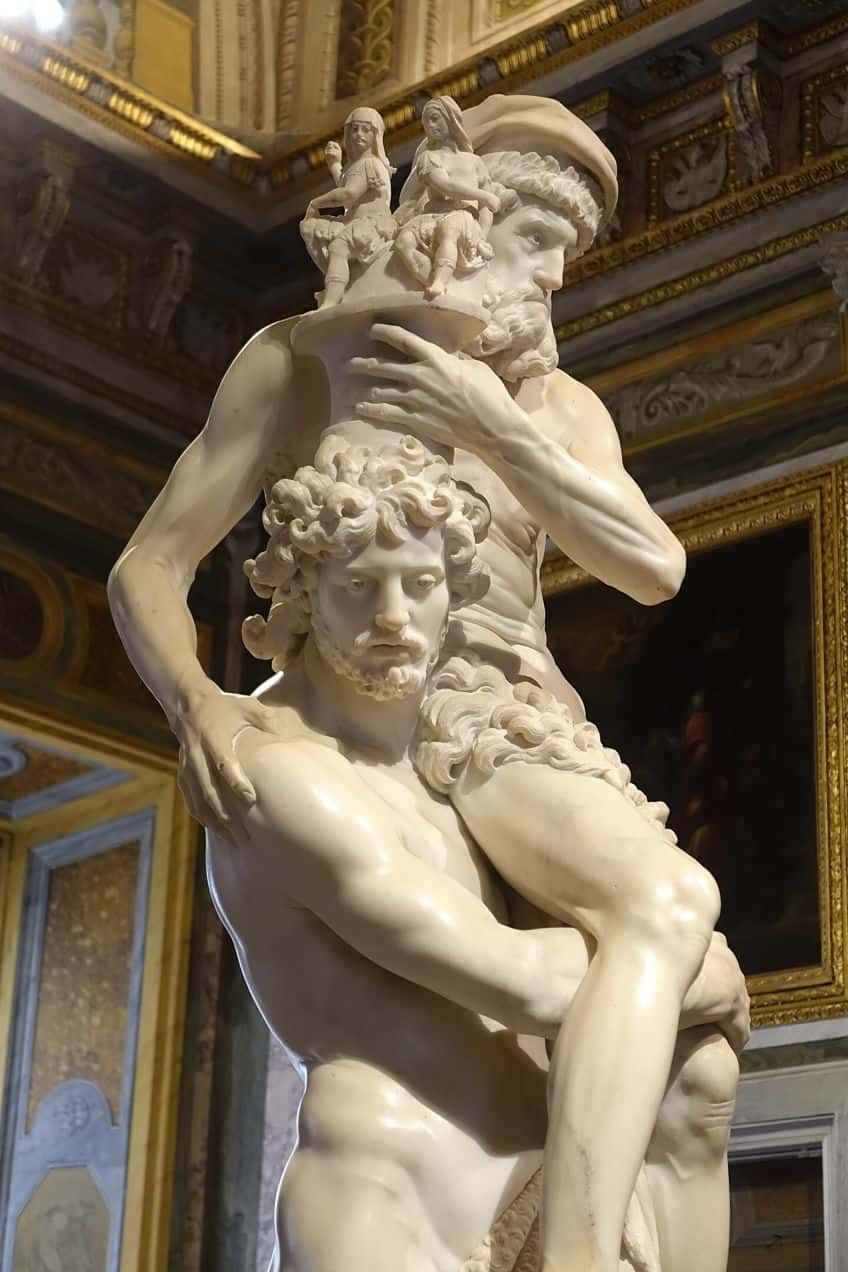
The Rape of Prosperina (1621 – 1622 CE)
| Date | 1621 – 1622 CE |
| Medium | Marble |
| Height (cm) | 225 |
| Current Location | Borghese Gallery and Museum, Rome, Italy |
This sculpture illustrates a scene from Ovid’s Metamorphoses. (8 CE) The scene features the Roman God, Pluto kidnapping the goddess Proserpina, who he is in love with, and taking her to the underworld, where he rules as king. Pluto is depicted holding a scepter and wearing a crown, with Cerberus, his three-headed hound, standing in the background to prevent any interference. Proserpina is attempting to flee as Pluto grabs her around the waist and thigh; she is depicted pushing his head away and flinging her other arm out for help that will never come.
Bernini was 23 years old when he produced this incredible work. After it was completed, Cardinal Scipione Borghese gave it to Cardinal Ludovisi, but after the Italian State bought the Villa Borghese in 1908, it was returned to the Borghese family. In this artwork, Bernini displays his affinity for depicting settings that are in the midst of dramatic action, luring the viewer in and capturing their complete attention.
The group is posed in a twisted contrapposto, or “figura serpentinata,” which allows the observer to see the entire scene from a single angle.
The intricacies of Pluto’s fingers pushing into Proserpina’s thigh, which provide an astonishing illusion in which the hard and cold marble appears soft and delicate in contrast with the violence, are what Bernini’s son Domenico called an “amazing contrast of tenderness and cruelty.” Daniele Pinton, an art historian, noted that the sculpture is typical of Bernini’s art in that it “depicts not a figure but an event.” In an effort to capture a specific moment in time, Bernini stops the action in the middle of the drama.
This piece was initially praised by critics, such as Howard Hibbard, who noted the realistic qualities Bernini had accomplished in his medium of choice. Subsequently, the work faced more negative criticism, especially in the 18th and 19th centuries, with some describing Bernini’s portrayal of Pluto as too decorative rather than the nobility associated with the God.
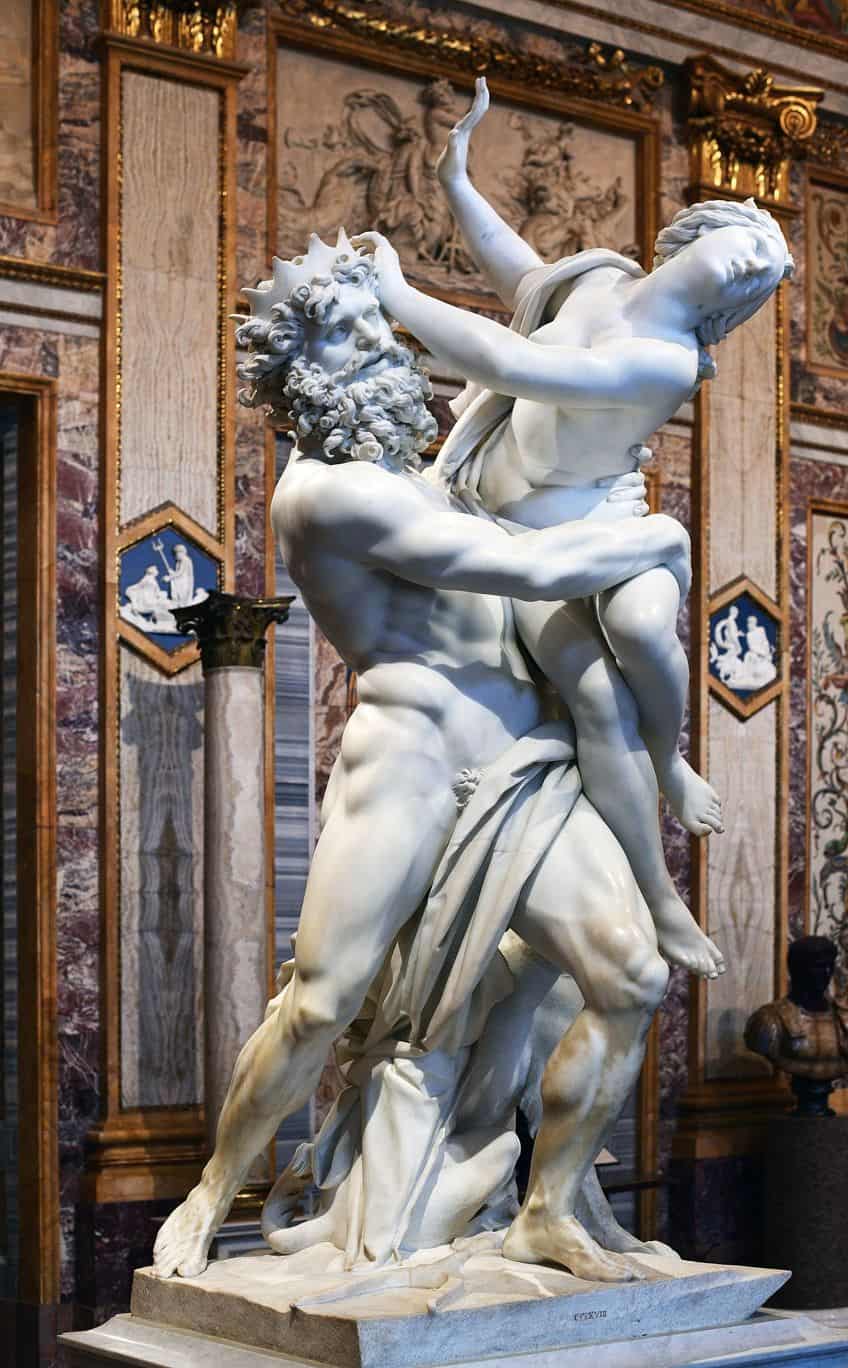
Neptune and Triton (1622 – 1623 CE)
| Date | 1622 – 1623 CE |
| Medium | Marble |
| Height (cm) | 182 |
| Current Location | Victoria and Albert Museum, London, United Kingdom |
Neptune and Triton was carved between 1622 and 1623 at the request of Italian Roman Catholic Cardinal Bishop Alessandro Peretti for the garden of the Villa Montalto in Rome. It was initially designed as the focal point of a sophisticated arrangement of fountains and cascades that was situated at the top end of a huge oval fishpond. In future centuries, this display became known as one of the most impressive groups of sculpture in Rome.
This sculpture depicts Neptune, (Poseidon to the Ancient Greeks) the god of the oceans, and his merman son, Triton. The two are sculpted to be life-sized. The dynamic scene may HAVE come from Ovid’s Metamorphoses (8 CE), which described a tale in which Jupiter, the king of the gods, called on Neptune to create a flood out of rage. A storm was unleashed as Neptune used his trident to strike the Earth.
Neptune put down his trident once the devastation was over, and he asked his son Triton to blow on his conch shell to signal the waves to calm down.
This can be seen in Bernini’s statue, with Triton depicted below Neptune’s knees, thrusting himself forward to blow the conch shell. He is depicted as a young man, maybe a teenager, with clearly defined musculature, blowing his shell. Neptune, with his beard and wavy hair, is depicted with the appearance of a 30-year-old man. He is carrying both himself and his son while standing on a large seashell with his legs apart. Neptune’s right shoulder is covered by a large sheet that is also sliding between his powerful legs, exposing some of his masculine anatomy.
Neptune and Triton appear to have been modelled by Bernini with expansive, far-reaching perspectives in mind. He used the strong Italian sunlight of the sculpture garden’s location to his advantage while also producing a striking overall design for the father and son figures. This resulted in dramatic contrasts of dark and light, with deep and furiously carved detail.
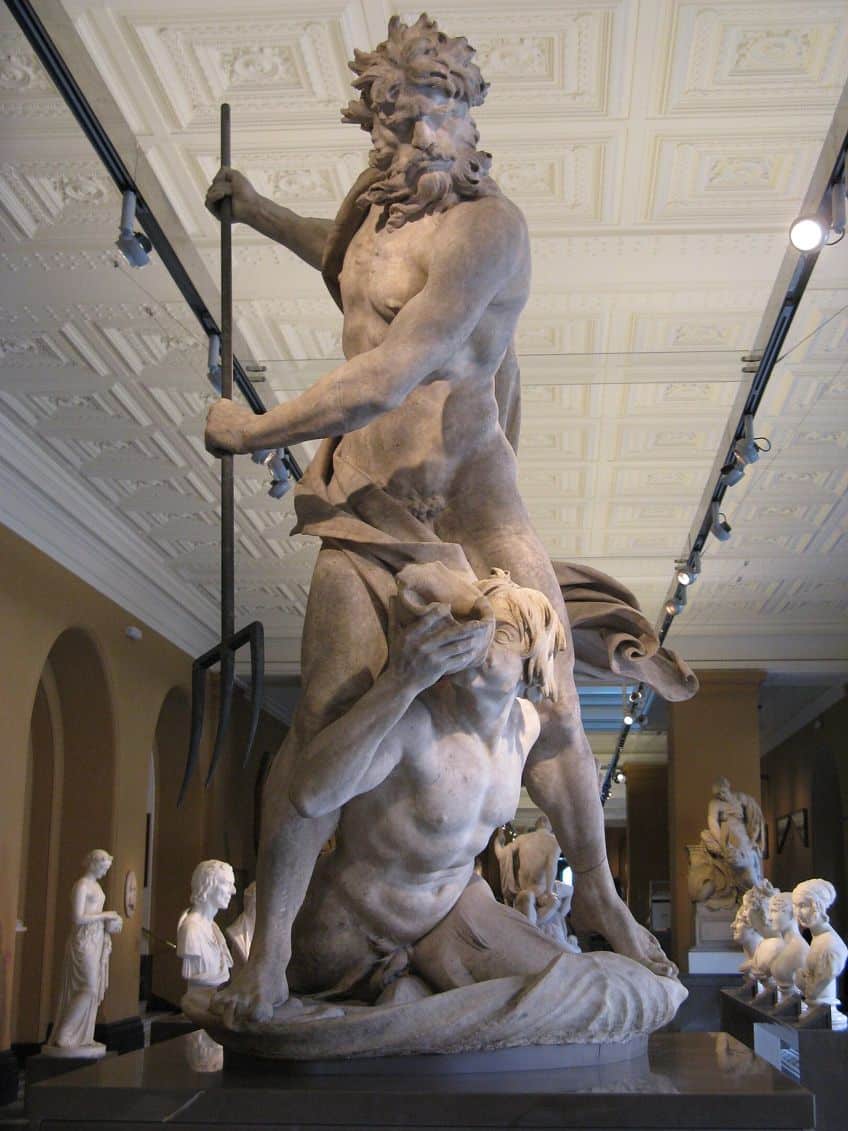
Apollo and Daphne (1622 – 1625 CE)
| Date | 1622 – 1625 CE |
| Medium | Marble |
| Height (cm) | 243 cm |
| Current Location | Borghese Gallery and Museum, Rome, Italy |
This sculpture, commissioned by Cardinal Scipione Borghese, was completed by Bernini at the age of twenty-seven. The work is similar to Bernini’s The Rape of Prosperina (1621 – 1622), which was given to Cardinal Ludovico Ludovisi, in that both pieces depict dynamics violent scenes. While this work was completed after David (1623 – 1624), Bernini actually began working on Apollo and Daphne first, before pausing construction to focus on David.
It was completed around 1625, possibly with assistance from a pupil by the name of Giuliano Finelli; subsequent works by Bernini were sometimes created in substantial part by helpers in his expansive workshop, without receiving any credit.
the sculpture shows the scene from Ovid’s Metamorphoses (8 CE) where the God of Light and Poetry, Apollo is struck by Cupid’s arrow and falls hopelessly in love with Daphne, a river nymph who pledged a vow of virginity to the Goddess of the Hunt, Diana. In the story, when Apollo pursues Daphne, she asks Diana for help, who then turns Daphne into a laurel tree for protection. This piece depicts the moment in which Daphne’s transformation begins, with her hands turning into tree branches.
Bernini designed the sculpture to be seen side on so the audience may completely comprehend the entire narrative of this enthralling story, even if different viewpoints can reveal additional details. When viewing the sculpture from the intended angle, the viewer is able to contrast Apollo’s surprised reaction with Daphne’s agony. As characterised for the Baroque period, the figures in the piece are dynamic, appearing as if moving, with Apollo’s clothes seeming to fly off of him as he reaches out to capture Daphne, and Daphne’s hair spinning out as though blasted by the wind. This produces a dramatic impact, a scene of great movement and feeling, and it demonstrates Bernini’s skill with marble.
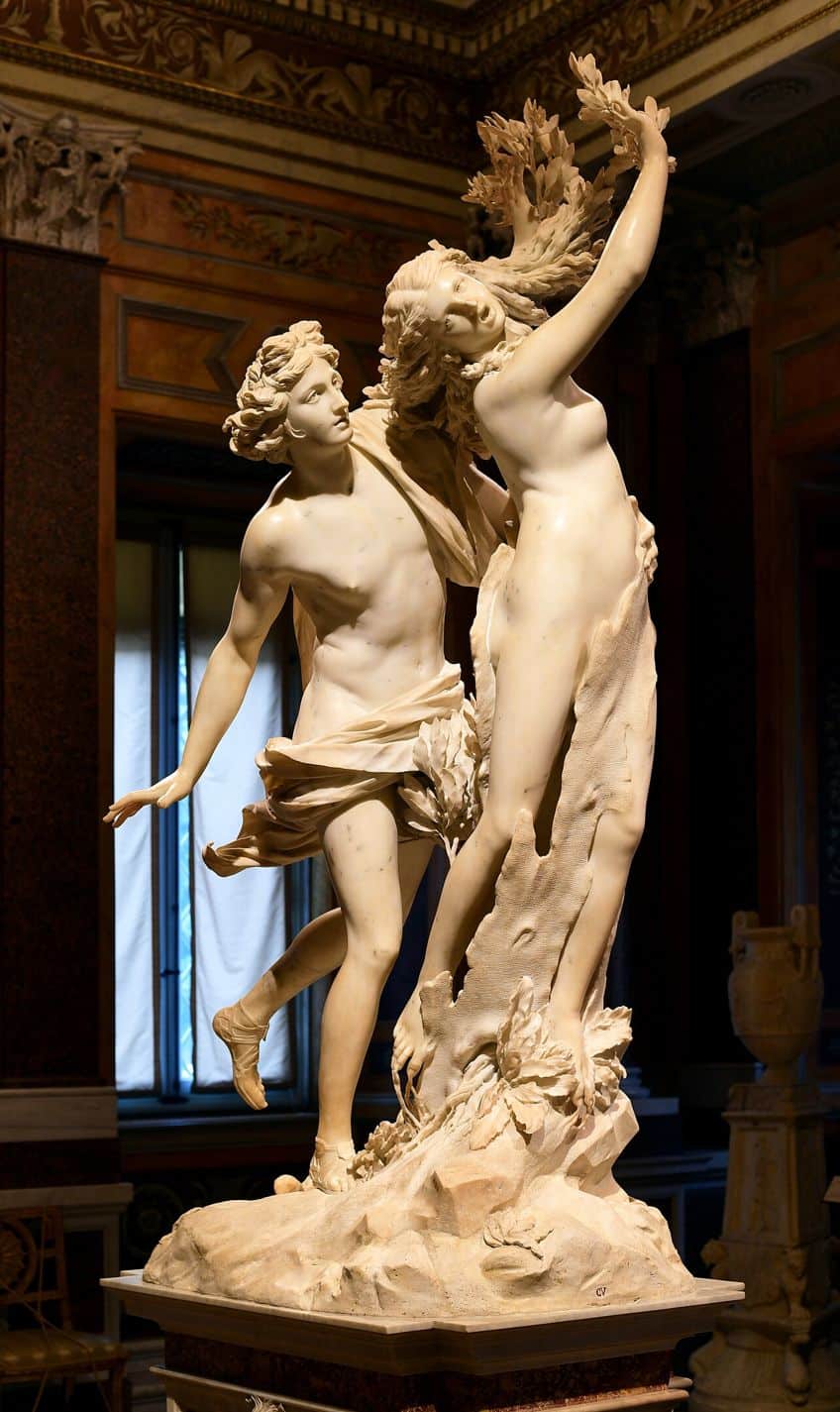
David (1623 – 1624 CE)
| Date | 1623 – 1624 CE |
| Medium | Marble |
| Height (cm) | 170 |
| Current Location | Borghese Gallery and Museum, Rome, Italy |
David, a life-size marble sculpture, depicts the biblical scene of David getting ready to throw the stone that would take down the giant, Goliath. The figure’s body is contorted, and he has a focused, tense look on his face. His body is in a position to swing his arm and hurl the stone, like a spring about to be released, and his eyes are locked on the unseen target. Included in the sculpture is David’s armor. According to the Biblical story, David took off his armor to allow him more freedom of movement, demonstrating his entire reliance on God’s protection.
Bernini’s David statue is representative of his signature portrayal of what photographer Henri Cartier-Bresson called “the decisive moment”, which refers to the moment in which all of the elements of the composition come together to create the perfect scene. By giving the appearance of movement through the figure’s pose and facial expression, Bernini conveys the idea that the figure is part of a larger narrative.
David‘s face was thought to be a self-portrait, according to Bernini’s son, which may have been how he got the precise look he desired, providing us with knowledge of how Bernini operated.
The piece is praised for pioneering psychological depth and indicated movement in sculpture, especially when compared to earlier representations of the theme. The sculpture displays a three-dimensional piece of shifting nature, and is designed to entice the viewer to move around it. As we cannot see Goliath, David’s rage and facial expressions make the viewer feel as though they are in the heart of the battle.
This sculpture demonstrates a significant transition from the Renaissance to the Baroque. While Bernini painted straight from reality, earlier Renaissance painters used old sculptures as their sources of inspiration. Renaissance painters and sculptors including Donatello, Verrocchio, and Michelangelo have all produced their own representations of David, with the most well-known sculpture today being Michelangelo’s David. (1501 – 1504) However, Bernini’s statue differentiated itself with its dynamic energy.

St. Peter’s Baldachin (1623 – 1634 CE)
| Date | 1623 – 1634 CE |
| Medium | Bronze |
| Height (cm) | 2874 cm |
| Current Location | St. Peter’s Basilica, Vatican City, Italy |
Located in St. Peter’s Basilica in Vatican City, Bernini created the intricately curved bronze St. Peter’s Baldachin. A Baldachin, also referred to as a ciborium, is a ceremonial canopy typically found in churches and tombs, used to visually emphasize the significance of a person or place. This piece is one of Bernini’s best works and can only be appreciated in person.
The Baldachin was a joint effort. Bernini had help from his opponent Francesco Borromini, his father Pietro, his brother Luigi, and other painters who created ornamental components. Because of this accomplishment and the fact that it was housed inside a dome designed by Michelangelo, Bernini was officially recognized as Rome’s most eminent sculptor.
Due to its size and elaborate construction, the canopy that covers the basilica’s high altar is a major focal point. Four helical columns with four sizable angels at each corner are placed on marble plinths.
The columns of this grand piece are shaped like keys, a nod to Jesus’ statement that he will give St. Peter the keys to paradise. A sphere and a cross are depicted on the canopy’s top, signifying the redemption of Christ. The baldachin is perched above St. Peter’s tomb and right beneath the basilica’s dome. This calls attention to the heavenly realm above, the earthly sphere of the church, and Hell below by being in this location.
Instead of having straightforward vertical support structures, its columns give the impression of twisting upward, and its top is covered with elaborate gilded decorations and allegorical figures. Bee sculptures may be seen all over the piece These refer to the commissioner of the piece, Pope Urban VIII’s family. The piece’s location within the grand building serves as a visual reminder of the immensity of God’s creation relative to the people on Earth by bringing attention to the size of the church in relation to the people within it.
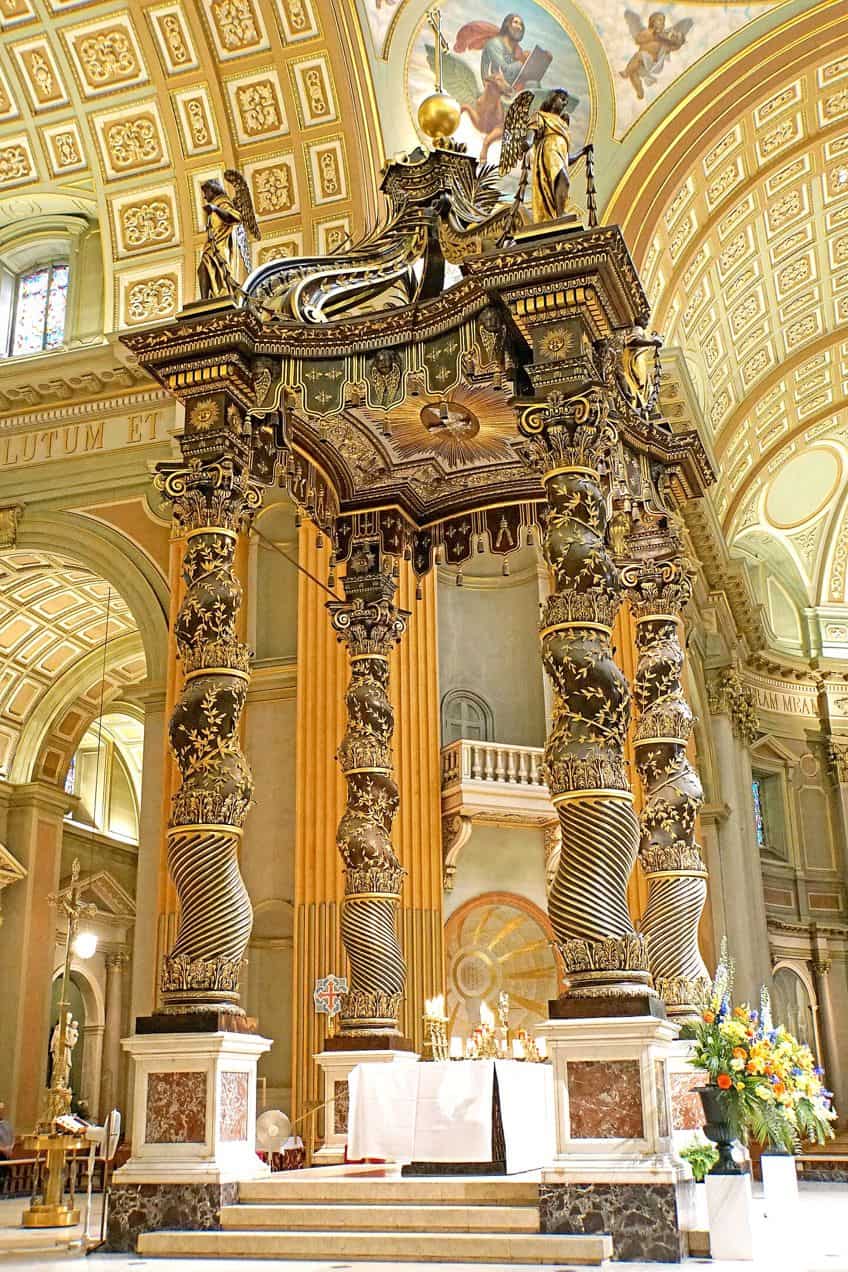
The Ecstasy of Saint Teresa (1647 – 1652 CE)
| Date | 1647 – 1652 CE |
| Medium | Marble |
| Height (cm) | 350, 5 |
| Current Location | The Church of Santa Maria della Vittoria, Rome, Italy |
By the mid 1600s, Bernini had built himself a well-respected reputation in Rome. This came to a halt, however, when Pope Innocent X became head of the Catholic Church in 1644. Pope Innocent X chose not to commission Bernini for sculptures in an attempt to differentiate himself from his predecessor. While Bernini no longer had the financial support from the Church, his work was able to continue through the commissions of the Roman elite.
Federico Cornaro, a Venetian Cardinal, commissioned Bernini to create an extravagant chapel for the Santa Maria della Vittoria cathedral in Rome, where Cornaro would be laid to rest, in the 1640s. One of the most famous sculptures from the High Roman Baroque is The Ecstasy of Saint Teresa.
It is a representation of Teresa of Avila, a well-known Spanish mystic, saint, Carmelite nun, writer, and theorist who championed a contemplative lifestyle filled with prayer.
The Bernini sculpture depicts Teresa in a trance and the angel brandishing a spear, alluding to a scene from the nun’s autobiography, The Life of Teresa of Jesus, where she fell into a state of religious ecstasy after meeting the angel. The cloud Teresa is laying on alludes to her ascending to heaven. The male members of the Cornaro family were portrayed by Bernini in life-size, high-relief donor portraits all around the sculpture, adding to the dramatic atmosphere with their sculptures’ sideways glances at the action.
In addition to the sculpture, Bernini created the interior architecture and decor of the chapel the piece resided in out of marble, paint, and stucco. This piece demonstrates Bernini’s technical prowess and creativity in his handling of marble. Teresa’s robes are represented spinning about her rather than the controlled folds of classical sculptures, giving the piece Bernini’s signature dynamic feeling.

Bust of Louis XIV (1665 CE)
| Date | 1665 (CE) |
| Medium | Marble |
| Height (cm) | 80 |
| Current Location | Palace of Versailles, Versailles, France |
The age of Absolutism had begun by the middle of the 17th century, with attempts being made by monarchs and religious leaders to seize absolute power in their own states. This meant competing with one another in various passive ways to gain influence beyond their own borders. So, King Louis XIV’s invitation to Bernini to visit France in 1665 was more than just a kind gesture; it was also meant to demonstrate that France had the ability to snatch up the adored artist of the Catholic Church. During Alexander VII’s reign, Bernini had won back the papacy’s favor. He was sent to France to design the Louvre, which at the time served as a royal residence.
While most of Bernini’s work was met with disapproval, there was one piece that was considered a success; The marble bust of Louis XIV of France.
This Bernini sculpture, known as the “grandest work of portraiture of the baroque period,” was carved in under three months as the artist sat with the Monarch. Domenico Bernini, the artist’s son and biographer, emphasized his father’s artistic justifications for the King’s agreement to sit for so long, adding that Bernini preferred to paint from reality rather than from drawings or portraits.
Drawing inspiration from ideas of valiant rulers like Alexander the Great, Bernini depicted Louis wearing armor. The King is shown as having a dignified demeanor that combines majesty with a deep refinement of soul. Bernini’s signature style can be seen with the cloth billowing out around Louis, rather than simply flowing down.
 Bust of Louis XIV (1665 CE) by Gian Lorenzo Bernini; Gian Lorenzo Bernini, CC BY-SA 3.0, via Wikimedia Commons
Bust of Louis XIV (1665 CE) by Gian Lorenzo Bernini; Gian Lorenzo Bernini, CC BY-SA 3.0, via Wikimedia Commons
Bernini art set the standard for Baroque sculpture. His work was dynamic and put the viewer right in the middle of the action, portraying intense emotion through his skilled sculpting. While his work received mixed criticism, he is today considered the best sculptor of the Baroque movement.
Take a look at our famous Bernini sculptures webstory here!
Frequently Asked Questions
What Is Bernini Best Known For?
Italian artist Gian Lorenzo Bernini, regarded as the best sculptor of the 17th century, is credited with creating the Baroque style of sculpture. He was also renowned for his magnificent architectural creations.
What Was Sculptor Bernini’s Style?
Gian Lorenzo Bernini invented Baroque art and architecture, with his swirling lines and large dynamic sculptures depicting characters from myth and religion. Baroque designs pay close attention to light and shadow, have curving lines, and use spirals to suggest movement.
What Was Bernini’s Most Significant Sculpture?
The Cornaro Chapel at Rome’s Santa Maria della Vittoria is the finest example of Gian Lorenzo Bernini’s mature work. The Ecstasy of St. Teresa (1647 – 1652), a sculpture by Bernini that depicts the renowned Spanish Carmelite nun, Teresa of Avila’s spiritual experience, is the centerpiece of the chapel.
Jordan Anthony is a Cape Town-based film photographer, curator, and arts writer. She holds a Bachelor of Art in Fine Arts from the University of the Witwatersrand, Johannesburg, where she explored themes like healing, identity, dreams, and intuitive creation in her Contemporary art practice. Jordan has collaborated with various local art institutions, including the KZNSA Gallery in Durban, the Turbine Art Fair, and the Wits Art Museum. Her photography focuses on abstract color manipulations, portraiture, candid shots, and urban landscapes. She’s intrigued by philosophy, memory, and esotericism, drawing inspiration from Surrealism, Fluxus, and ancient civilizations, as well as childhood influences and found objects. Jordan is working for artfilemagazine since 2022 and writes blog posts about art history and photography.
Learn more about Jordan Anthony and about us.
Cite this Article
Jordan, Anthony, “Bernini Sculptures – Discover the Famous Baroque Sculptor.” artfilemagazine – Your Online Art Source. October 4, 2023. URL: https://artfilemagazine.com/bernini-sculptures/
Anthony, J. (2023, 4 October). Bernini Sculptures – Discover the Famous Baroque Sculptor. artfilemagazine – Your Online Art Source. https://artfilemagazine.com/bernini-sculptures/
Anthony, Jordan. “Bernini Sculptures – Discover the Famous Baroque Sculptor.” artfilemagazine – Your Online Art Source, October 4, 2023. https://artfilemagazine.com/bernini-sculptures/.


